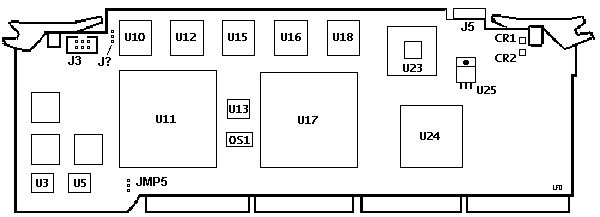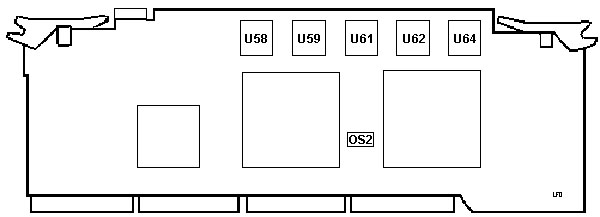P Type 4 Complex
Rf90954a.exe Reference disk for Type 4 Complexes
Rd9095a.exe Common Diagnostics for all 859x
/ 959x Systems
Type 4 Common Devices
"P" / Upgrade Pentium 60 MHz 52G9362
Memory supported, cache, features
Support for Convenience Partition
on >3.94GB Drives
BIOS releases
Flash BIOS 05 from
BIOS 03 or less
BIOS Level Revison
Features
FDIV Replacement
Diagnostic LEDs
Intel Pentium Overdrive 133MHz
(POD133/120)
496 vs. 497 Cache Controller
"P" / Upgrade Pentium 60
MHz 52G9362

U23 10G3441
Synchrostream Controller- may be yellow (early) or blue (fixed). I have
a ceramic version and Peter has seen a metal capped one. Version
trivia
P Complex Back

OS2 40 MHz MCA Bus Clock
Intel Pentium Overdrive
133MHz (POD133/120)
From Terminaut
I dug through craploads of old Intel documents today,
and found my notes from Intel (circa '95) for the Pentium Overdrive 133MHz
(POD133/120) processor.
Written in plain ingles, the Intel doc says: "will not
support the 82496 Cache Controller and 82491 Cache SRAM chip set"
Additionally, the documentation states that the POD133
is designed to support _PCI_ chipsets.
Some other notes:
- IU, IV, and IBT plus have been removed
- branch trace pins (BT[3:0]) have been removed (no execution
tracing)
- breakpoint pins (BP[3:0]) have been redefined such that each
assertion of one of these pins indicates that 1 to N BP matches occurred,
where N =core/bus frequency ratio
- STI/CLI (restore/clear interrupts) are each 2 clocks shorter
496 vs. 497 Cache
Controller
From Dr. Jim Shorney
Overdrive processors are not compatible with the '496
cache controller on the P60/66 complexes. However... I swapped
out the '496 cache controller on mine for a borrowed '497 (well heatsinked)
and was able to boot DOS with a POD 133 on my P60 (overclocked to 66).
It wasn't entirely stable, and would not boot OS/2 Warp 4.0 or NT 4.0.
The Powerleap PL54C interposer was still dead in this configuration.
There may yet be hope, I haven't tried the Powerleap with anything other
than an Intel 166 yet, and I may also downclock the complex back to 60
MHz and see what happens. There may yet be hope...
The '497 reportedly has a 3.3v core,
but it seemed to run stable and reliable for several hours with the stock
P60 CPU in my system in place of the 5v '496. I briefly looked
over the docs this afternoon (712 pages, wow...). Seems the '497 is still
a 5v part, it is the I/O buffers that connect to the CPU that are 3.3v.
This probably explains in part why the chip doesn't self-destruct in the
'496 socket. It also seems to invalidate the need for an interposer,
since the P60/66 I/O is 5v anyway and the buffers would have to run at
5v to interface at all with the CPU. This brings up the question
of noise immunity, though - will circuits designed to run at 3.3v logic
levels be more or less sensitive to noise or poor signal quality when run
at 5v? Inquiring minds want to know.
From Tony Ingenoso
I suspect noise is going to be less of a problem
at higher voltages Jim. In theory, the voltage range for correct
operation would be wider(particularly for CMOS). The only reason
I ever saw (other than laptop applications) for the drive to lower voltages
was to limit heat as the gate counts and frequencies went up. CMOS
parts like high voltages -- you can crank clock speeds faster with higher
voltages(the standard overclockers trick). Discrete type CMOS parts
can often be run as high as 20V and work fine. The downside is that
its power characteristics start approaching those of TTL at the higher
speeds (and heat goes up). If the only nominally 3.3V sections of
the cache controller are the line drivers/buffers, there's probably not
going to be enough stuff getting overvoltaged to make any significant difference
in the power draw.
9595 Server 95 (AKA "Server 95 560")
9595-0PT - P60, 16/256MB (ECC), 1GB SCSI-2 F/W, 2.88
9595-0PTF - As above - Canadian French
9595-0PV - P60, 16/256MB (ECC),2GB SCSI-2 F/W, 2.88
9595 Server 95 Array Models (called 95A)
9595-3PG - P60, 16/256MB (ECC), 3 x 540MB SCSI-2 F/W, 2.88
9595-3PT - P60, 16/256MB (ECC), 3 x 1GB SCSI-2 F/W, 2.88,
9595 Main
Page
|
